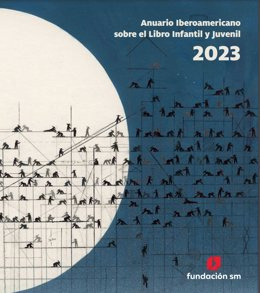(Information sent by the signatory company)
- The SM Foundation publishes the seventh Ibero-American Yearbook on Children's and Young People's Books, a work that offers a balance of everything that has happened in the LIJ sector in Ibero-America throughout 2021 and 2022.
- Children's and Young People's Literature (LIJ) continues to gain positions in the Spanish market. In 2021, almost 9,000 LIJ titles were published in our country, which translated into 50 million copies.
- 78% of Spanish children between 10 and 14 years old are readers in their free time. 65% of adolescents between 14 and 18 years old read once a week, but the percentage drops significantly after the age of 18.
- This age group is the one in which reading rates have increased the most, due in part to the booming role of comics, the significant rise in digital reading and the appearance of new genres.
- The Yearbook includes an article about comics in Spain written by Álvaro Pons and Noelia Ibarra, directors of the SM-Universitat de València Foundation Chair of Comic Studies.
Madrid, January 2, 2024.- The SM Foundation publishes the 14th edition of the Ibero-American Yearbook on Children's and Young People's Books 2023, which offers detailed information on the sector in Argentina, Brazil, Chile, Colombia, Ecuador, Spain, Mexico , Peru, Puerto Rico and the Dominican Republic throughout 10 monographic articles, as well as a general overview of the region, an article on children's and youth comics in Spain, and three articles on the LIJ in Catalan, Galician and Basque.
It is a collective work carried out by specialists in the world of Ibero-American Children's and Youth Literature, which began to be published biannually in 2012. Due to the fact that comics are increasingly being published and read more, this edition includes an article dedicated entirely to him.
María Teresa Ortiz, director of the SM Foundation, points out that the biannual publication of the Yearbook “responds to our commitment to promoting reading as a fundamental axis to achieve educational equity and, consequently, people with a reading habit that allows them to learn the length and breadth of life.”
The biennium analyzed covers (2021 and 2022) corresponds to the return to a certain normality after COVID-19, with the appearance of new reading habits derived from confinement, with a significant rise in digital reading, with a thriving role of comics and with the appearance of new genres, which has meant that reading rates in children and young people are the fastest growing in this period.
"From reading the articles we can conclude that, after living through a very difficult period, we are going through a difficult but fruitful stage, during which all agents in the sector (publishers, authors, illustrators, booksellers, librarians...) have shown a great resilience and desire to do things. Sadly, publishers have disappeared, but new ones have emerged,” explains Teresa Tellechea, coordinator of reading promotion programs at the SM Foundation.
The LIJ in Spain: bold, free and diverse
For Pepe Trívez, literary specialist and author of the chapter The LIJ and its readers, the driving force of reading in Spain, “the LIJ proposals are increasingly bolder, more diverse, more free. The undoubtedly excessive offer of themes, formats, styles, etc., makes more demanding, artistic, even reflective works appear, others with an infinite number of layers and levels of understanding and interpretation; works often described as “difficult”, but of unquestionable value and with a truly necessary approach.”
The LIJ currently represents 16% of the total book market, with almost 9,000 titles published throughout 2021 and 2022 and more than 50 million copies published.
According to the Report on reading and book purchasing habits in Spain, published every year by the Federation of Publishers' Guilds, almost 76% of households with children under 6 years of age read books daily, preferably in paper format.
But without a doubt the most important thing about this last biennium is that 83.7% of children aged 6 to 9 read books in their free time voluntarily. On the other hand, adolescents are the most likely to read in digital format and exchange literature for web pages and texts on social networks. They are also the ones that have increased in all the reading rates published in the last two years, however, these rates fall sharply after the age of 18.
Sagas, mystery, adventure, romance, thriller, social realities, ecology... are part of the usual themes of the LIJ and are, without a doubt, what sustain these sales and reading figures.
Trends: illustrated, sagas, comics and environmental concern
The illustrated album continues to be the preferred “genre” for pre-readers and for mediated reading in the family, school, and libraries.
For independent readers, the LIJ publishing market offers such a variety that it is difficult to categorize, books of stories and stories intersect with the exploration of other cultures and the no less interesting exploration of emotions.
Aimed at all ages, sometimes unfairly valued for their serialization, it seems inevitable to point out the good health enjoyed by many of the sagas aimed at children and young people.
A topic that makes sense today has to do with environmental concern, not only from information books, but also from fiction, as well as technology, both in narrative and in the incorporation of new transmedia discourses, the use of QR codes in books and the different digital narratives, interactive books and the new generations of influencers on social networks.
Youth literature has been moving for some time on the borders in which authors seem to find themselves more and more comfortable. The young adult phenomenon has had a very important impact in our country. The historical novel has a clear niche in literature for young people and adolescents, however, one of the trends that had been growing, dystopias, is stagnating.
Children's poetry has become more than a genre, it has been recovering the space it always had and the novelty now lies in ambition, in the conviction that poetry can be a privileged vehicle to reach readers regardless of their age.
The Yearbook has confirmed the importance of reading theater and, in fact, several publishers have included theater among their LIJ offerings. Children's theater already had a place in the catalogs – a result, surely, of its prescriptive use in school – and now the novelty is in a theater aimed specifically at young people and adolescents, with a clear vocation to be performed.
The rebound in children's and youth comics in Spain follows the global trend in its increase in publications and sales. 43% of the total comics launched on the market throughout this two-year period were children's. This boom is due to several reasons: the increase in reading after confinement, the rebound in manga (it accounts for 30% of comic titles) and the creation of children's comic collections in many publishers.
Access the full study by clicking here
SM Foundation
The SM Foundation is a non-profit educational institution that works so that, through education and culture, no girl or boy is left behind. We direct all our initiatives towards improving educational equity and quality from four areas of intervention: Educational Research, Socio-Educational Assistance Projects, Teacher Training and Educational Editorial Innovation Projects.
We are backed by more than forty-five years of experience in the development of educational and cultural projects in Spain and Latin America. The SM Foundation allocates the benefits derived from SM's business activity to programs that, through education, seek to contribute to a more inclusive, fair, peaceful and sustainable world.
Communication SM Spain
comunicacionsm@info.grupo-sm.com
Carmen Palomino - (34) 649 454 680
Goretti Redondo - (34) 664 779 481













